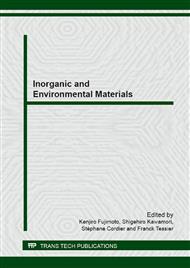p.46
p.50
p.61
p.68
p.72
p.81
p.85
p.89
p.94
SPS Using SiC Die
Abstract:
Possibility of a use of SiC as SPS die was examined. Although SiC has good strength even at high temperature, electrical conductivity is too low as the SPS die. Maximum output voltage of typical SPS machine is 10 V. Joule heat of SiC by application of 10 V is too small to increase its temperature. One idea to solve this problem in this study is to apply higher voltage to the SiC die. Using prototype high voltage SPS equipment, the temperature of SiC die was successfully elevated. Another idea is to heat the SiC die in advance. SiC has a semiconducting behavior, so that the electrical conductivity at high temperature becomes sufficient for the ordinary SPS equipment. Using SPS machine which has hot-wall, heaters surrounding the die, the temperature of the SiC die was successfully increased by application of low voltage. This SPS had similar sintering effects as the ordinary ones. Partly transparent alumina was successfully prepared. Initial compositional fluctuation of Pb (Zr,Ti)O3 was maintained after it was densified by this SiC-SPS.
Info:
Periodical:
Pages:
72-77
Citation:
Online since:
June 2014
Authors:
Keywords:
Price:
Сopyright:
© 2014 Trans Tech Publications Ltd. All Rights Reserved
Share:
Citation:


